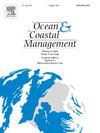基于多方法的中国海洋经济脆弱性时空评价
IF 5.4
2区 环境科学与生态学
Q1 OCEANOGRAPHY
引用次数: 0
摘要
海洋经济脆弱性时空评价对于优化海洋经济空间布局、促进海洋经济可持续发展具有重要意义。本文分别运用突变级数法和木桶理论对中国各省和海洋经济圈的经济价值进行了评价。采用Dagum基尼系数分解和核密度估计方法,分析了城市生态环境差异的来源和时空特征。应用障碍度模型,得到了影响机动车辆行驶速度的因素。主要发现如下:社会和资源子系统主要处于高或极高脆弱性,经济和环境子系统主要处于中或低、低或极低脆弱性。3种mec的MEV均为中等,且呈下降趋势。大部分省份的经济效益持续改善,但表现为空间不均衡。mec间差异增大,高变密度是其主要来源。南北MEC分布分化,东部MEC分布集中。为减少中国的经济增加值,三方应加强区域间合作,促进内部协调发展,各省应根据实际情况实施有针对性的政策。本研究也可为其他国家和地区的经济中心评价及均衡发展提供参考。本文章由计算机程序翻译,如有差异,请以英文原文为准。
Spatiotemporal evaluation of marine economy vulnerability in China: A multi-method approach
The spatiotemporal evaluation of marine economy vulnerability (MEV) is crucial for optimizing the spatial layout of the marine economy and promoting its sustainable development. This study applies catastrophe progression method and wooden barrel theory to evaluate the MEV of provinces and marine economic circles (MECs) in China, respectively. By using the Dagum Gini coefficient decomposition and Kernel density estimation methods, it analyzes the sources of differences and the spatiotemporal characteristics of MEV. It applies obstacle degree model to obtain the influencing factors of MEV. The key findings are as follows: The social and resource subsystems were mainly of high or very high vulnerability, and the economic and environmental subsystems were mainly of medium or low, low or very low vulnerability, respectively. The MEV of three MECs was all medium, and showed a decreasing trend. The MEV of most provinces continued to improve, but it manifested as spatial disequilibrium. The difference among MECs increased, and hypervariable density was its main source. The distribution of the northern and southern MECs diverged, while that of the eastern MEC concentrated. To reduce the MEV of China, the three MECs should strengthen inter-regional cooperation and promote coordinated internal development, while each province should implement tailored policies based on its actual situation. This study can also provide a reference for the evaluation of MEC and the balanced development in other countries and regions.
求助全文
通过发布文献求助,成功后即可免费获取论文全文。
去求助
来源期刊

Ocean & Coastal Management
环境科学-海洋学
CiteScore
8.50
自引率
15.20%
发文量
321
审稿时长
60 days
期刊介绍:
Ocean & Coastal Management is the leading international journal dedicated to the study of all aspects of ocean and coastal management from the global to local levels.
We publish rigorously peer-reviewed manuscripts from all disciplines, and inter-/trans-disciplinary and co-designed research, but all submissions must make clear the relevance to management and/or governance issues relevant to the sustainable development and conservation of oceans and coasts.
Comparative studies (from sub-national to trans-national cases, and other management / policy arenas) are encouraged, as are studies that critically assess current management practices and governance approaches. Submissions involving robust analysis, development of theory, and improvement of management practice are especially welcome.
 求助内容:
求助内容: 应助结果提醒方式:
应助结果提醒方式:


